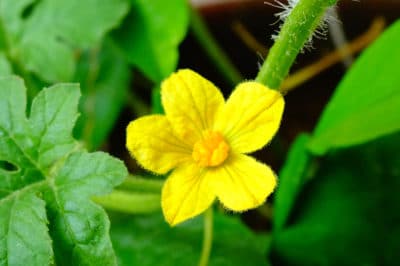Botany of the Watermelon Flower
Watermelons belong in the same family as squash, cucumbers and other melons, Curbitaceae, therefore, their yellow, perfect flowers look very similar to each other. Most varieties of watermelons are monoecious, meaning each plant produce both and male and female flowers, making pollination easier. Seedless types only produce female flowers, thus, they require help with pollination.
Basic differences in male and female watermelon blossoms:
- Male Flowers: Male watermelon flowers are the first to bloom. The stem that leads to the flower is thin, and the center of the flower is covered with small anthers filled with pollen and is devoid of any bulging.
- Female Flowers: Female flowers form after the males, their center contains a round-shaped stigma and a fuller undeveloped shape containing the unpollinated fruit. About every seventh flower is a female.
Expert Tip: Depending on the watermelon variety and the days to harvest, vines start producing flowers about 30 days after germination.
It’s All About Pollination
When it comes to watermelon flowers and how they achieve pollination, honeybees and other native bees do all the work. Therefore, it’s important not to use toxic chemicals in your garden that can kill these beneficial pollinators or decrease their population, especially during the period of blooming.
A good way to increase the visits of bees and other beneficial pollinators is by planting pollinating, flowering plants that these little work horses like call upon to drink nectar.
Female watermelon flowers require around 500 to 1000 grains of pollen for proper pollination. This means that bees makes anywhere from eight to 20 visits to each flower for effective fertilization. Misshapen watermelons are a sign that the pollination was inadequate.
Pollination Timeframe
There’s a short timeframe for female watermelon flowers to receive proper pollination. The flowers open right after sunrise and close in the afternoon, never opening again regardless of whether the flowers were pollinated or not.
Bee activity to the plants decrease during adverse weather, such as rainy, cold, or windy conditions. This can have effects on the outcome of the melons, which end up being smaller than normal due to inadequate pollination.
Pollination and Diploid and Triploid Watermelons
To make things even a bit more confusing seeded watermelon varieties are classified as “diploid” and seedless types “triploid.” What type of watermelon you are growing affects how the flowers are pollinated, and if you need to take additional steps to assure your plant sets fruit.
- Diploid Watermelons: Seeded watermelons are diploid, meaning they receive a set of chromosomes from each parent resulting in four. This results in the plant producing both male and female flowers, which the pollinated results in fruit with viable seeds.
- Triploid Watermelons: Seedless varieties of watermelons are triploid, meaning they have an odd number of chromosomes, and results in only female flowers produced on a plant. Due to the lack of a male, flowers are unable to pollinate themselves and produce fruit without seeds or a few that are sterile.
Pollinating Seedless Varieties
When growing a seedless watermelon variety that only produces female flowers, it’s important to grow a seeded variety too to assure the flowers receive pollen. Plant one row or hill of the seedless melons and then another of the seeded types. This assures the male flowers from the seeded variety pollinate the seedless flowers, thus resulting in fruit.
